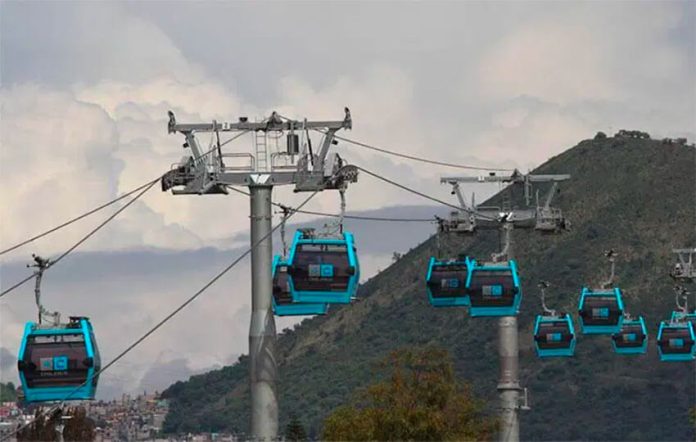Daily ridership on a public transit cable car line in the north of Mexico City is now 78% higher than anticipated, and passenger numbers are expected to continue to grow, according to the company that built it.
Up to 50,000 passengers per day are using Line 1 of the Cablebús, which connects Cuautepec, a working-class neighborhood in a hilly area of the Gustavo A. Madero borough, to the Indios Verdes Metro and bus station, located some nine kilometers away in the same borough. The line officially opened last July, although cable cars began operating on one section in March 2021.
The CEO of Doppelmayr México, the company that built the line, told the newspaper Milenio that daily ridership was predicted to be about 28,000.
“If we look at the feasibility study, [which was released] when the construction of the system was announced in 2019, it said that we were going to have approximately 28,000 passengers per day. In recent weeks, recent months … we’ve had an average of between 45,000 and 50,000 passengers per day – almost double what the study said,” Konstantinos Panagiotou said.
(The only feasibility study that Mexico News Daily was able to find predicted daily demand of 50,015 passengers. But another report stated that the city government’s tender documents also used the 28,000 daily riders figure.)
“We believe that [ridership] is going to increase,” he added. “The system is ready to reach 160,000 passengers per day, and we believe that we could have very big numbers very soon.”
One regular user is Carlos, who has lived in Cuautepec for the past nine years. He told Milenio that he prefers the Cablebús over other forms of public transit because passengers are not targeted by criminals.
“Cuautepec is a hot spot [for crime] in Mexico City and on public transport there is a lot of pickpocketing, … they take your wallet, your phone, whatever you have in your bag,” Carlos said, adding that robberies in which thieves demand that passengers hand over their belongings are also common on buses.
“Here [on the Cablebús] I feel safer, I travel with greater confidence and I can take my phone out with more peace of mind,” he said.
One downside is that cable car trips are not always as smooth as passengers would like. “The movement scares us a bit at times but it’s tolerable. Sometimes [the cable cars] feel very unstable, kind of like there are waves, there are people who get very scared, … they shout or begin to panic,” Carlos said.
Passengers have also complained about stoppages that leave them suspended in mid-air, but Panagiotou said they are “very short” and don’t present a safety risk.
“I understand that people are not used to being up high 45 meters from the ground … but the system is safe when it’s stopped, there’s no problem,” the Doppelmayr CEO said.
“… The stoppages we have are preventative stoppages – stoppages of one minute, a minute and a half, to check that everything is OK. … It’s not a [system] failure, it’s a preventative stoppage to continue maintaining passengers’ safety,” he said.
There have been no technical failures on Line 1 of the Cablebús since it opened, Panagiotou said. He also said that Doppelmayr – an Austrian manufacturer of ropeways and people movers – hopes to participate in the construction of Line 3, which will link the four different sections of Mexico City’s Chapultepec park. Construction is slated to commence in late 2023.
“Doppelmayr is a company that manufactures cable car systems so where there are cable car projects we’re always interested in participating, especially in Mexico City. … We’re waiting for the tendering process, … of course we’re interested in participating,” Panagiotou said. “… We believe that this line could work both for tourists [and residents] as public transit,” he added.
Line 2 of the Cablebús, which was built by Italian company Leitner Ropeways, opened in the eastern borough of Iztapalapa last August. The first cable car system to be established in the Valley of México metropolitan area was the Mexicable, which began operations in Ecatepec, México state, in 2016.
With reports from Milenio
